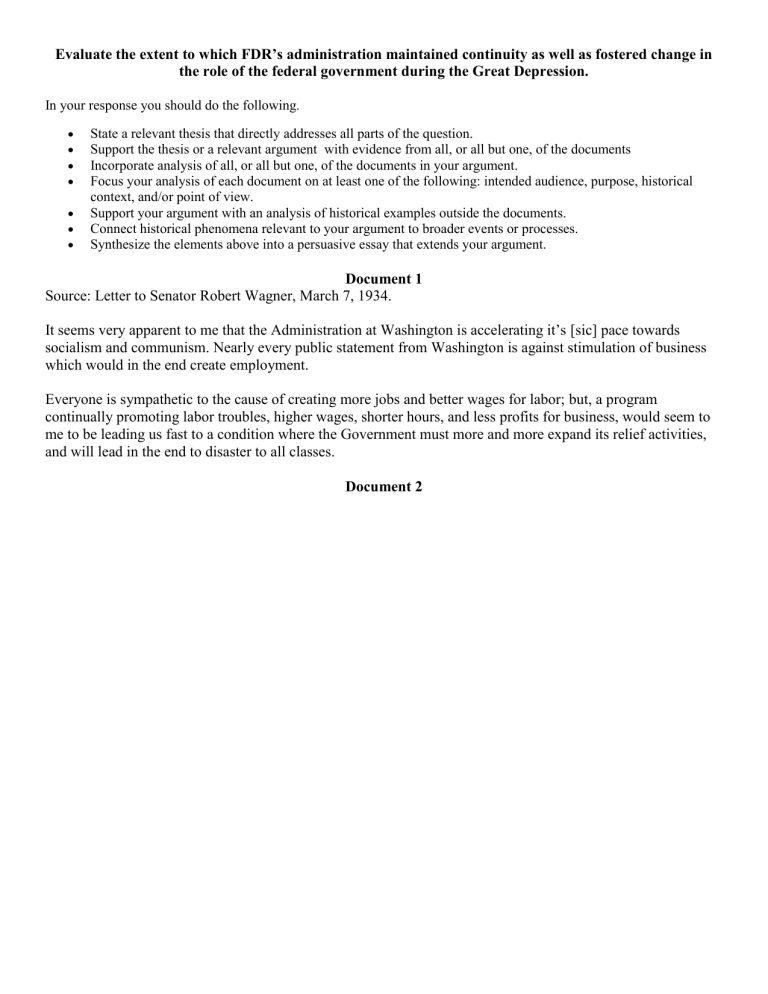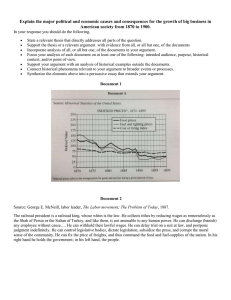Evaluate the extent to which FDR's administration maintained

Evaluate the extent to which FDR’s administration maintained continuity as well as fostered change in the role of the federal government during the Great Depression.
In your response you should do the following.
State a relevant thesis that directly addresses all parts of the question.
Support the thesis or a relevant argument with evidence from all, or all but one, of the documents
Incorporate analysis of all, or all but one, of the documents in your argument.
Focus your analysis of each document on at least one of the following: intended audience, purpose, historical context, and/or point of view.
Support your argument with an analysis of historical examples outside the documents.
Connect historical phenomena relevant to your argument to broader events or processes.
Synthesize the elements above into a persuasive essay that extends your argument.
Document 1
Source: Letter to Senator Robert Wagner, March 7, 1934.
It seems very apparent to me that the Administration at Washington is accelerating it’s [sic] pace towards socialism and communism. Nearly every public statement from Washington is against stimulation of business which would in the end create employment.
Everyone is sympathetic to the cause of creating more jobs and better wages for labor; but, a program continually promoting labor troubles, higher wages, shorter hours, and less profits for business, would seem to me to be leading us fast to a condition where the Government must more and more expand its relief activities, and will lead in the end to disaster to all classes.
Document 2
Document 3
Document 4
Source: Charles Evans Hughes, majority opinion, Schechter v. United States , 1935.
The question of chief importance relates to the provision of the codes to the hours and wages of those employed
. . . It is plain that these requirements are imposed in order to govern the details of defendants’ management of their local business. The persons employed . . . are not employed in interstate commerce. Their wages have no direct relation to interstate commerce . . .
The authority of the federal government may not be pushed to such an extreme.
Document 5
Source: NBC radio broadcast, John L. Lewis, December 13, 1936.
It is the refusal of employers to grant such reasonable conditions and to deal with their employees through collective bargaining that leads to widespread labor unrest. The strikes which have broken out . . . especially in the automobile industry, are due to such “employee trouble.”
Huge corporations, such as United States Steel and General Motors . . . have no right to transgress the law which gives the workers the right of self-organization and collective bargaining.
Document 6
Source: “The Roosevelt Record,” editorial in
The Crisis , November 1940.
To declare that the Roosevelt administration has tried to include the Negro in nearly every phase of its program for the people of the nation is not to ignore the instances where government policies have harmed the race. . .
At Boulder Dam, for example, the administration continued the shameful policy begun by Hoover of forbidding
Negroes to live in Boulder City, the government-built town. And in its own pet project, the TVA, the administration forbade Negroes to live in Norris, another government-built town at Norris Dam.
[The] most important contribution of the Roosevelt administration to the age-old color line problem in America has been its doctrine that Negroes are a part of the country and must be considered in any program for the country as a whole. The inevitable discriminations notwithstanding, this thought has been driven home in thousands of communities by a thousand specific acts. For the first time in their lives, government has taken on meaning and substance for the Negro masses.
Document 7





